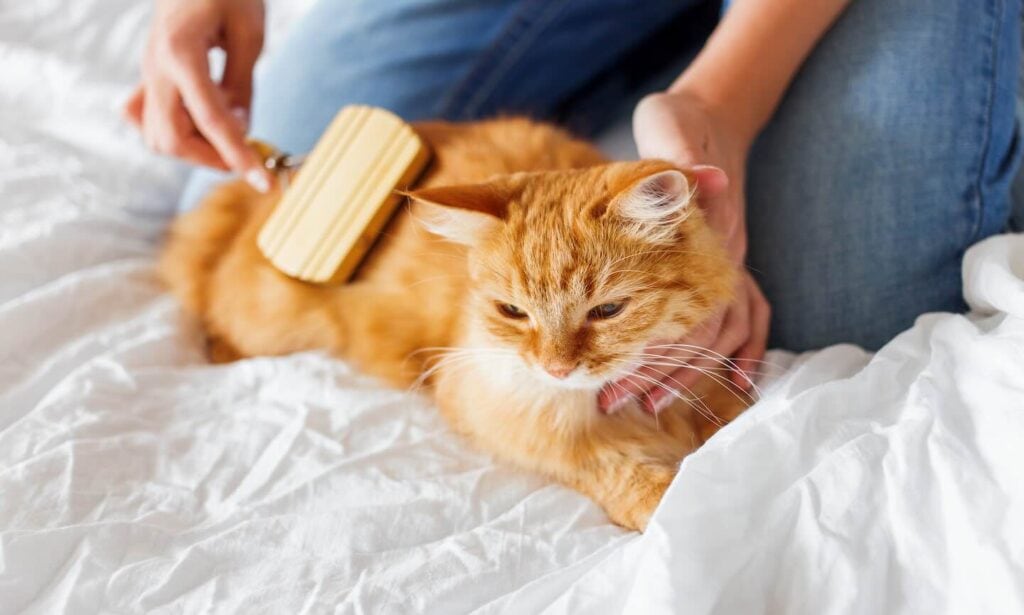Here’s the thing about cats: They’re pretty darn good at keeping themselves tidy thanks to their rough tongues and inherent affinity for cleaning themselves day and night. Still, our feline friends sometimes need a little cat grooming assistance from their humans.
But because they’re not always the most receptive to grooming intervention, learning how to groom a cat takes a little finessing. These expert tips can help.
Cats are superstars when it comes to keeping their coat in tip-top condition. This is unlike dogs, who require routine baths and sometimes even appointments with a professional groomer.
That said, felines do need help from time to time for various grooming-related tasks—most notably to keep their interior ears healthy, toenails the right length, and coats free of knots and matted fur.
“Regular grooming helps prevent health problems and allows you to detect any issues early,” says Michelle Dulake, DVM, a veterinarian based in Los Angeles. “Clean ears prevent infections, trimmed nails reduce the risk of injury, and clear eyes can signal overall good health. Dental care is crucial for preventing tooth decay and gum disease, which can lead to more serious health issues if left untreated.”
To ensure your cat grooming skills are up to snuff, follow these expert tips on how to groom a cat.
1 Get the Right Cat Grooming Tools
You’ll need all the necessary tools on hand for grooming cats. Dr. Dulake recommends investing in quality grooming tools designed specifically for cats to ensure safe and effective grooming sessions.
- Cat grooming brush, like the Safari Slicker Brush.
- A small cat toothbrush and cat-approved toothpaste. Try the Virbac C.E.T. bundle.
- Cat nail clippers, such as these by Frisco.
- Ear cleaning solution or wipes, like Virbac Epi-Otic.
2 Start When They’re Young
Establish a grooming routine when your cat is young, advises Cristy Brusoe, a certified cat behaviorist in Tampa Bay, Florida. “This helps them acclimate to being handled and groomed regularly,” she explains.
If you adopt an older cat, she says, start slowly and gradually build up their tolerance to grooming activities.
3 Be Gentle and Patient
Cats are decidedly independent creatures, and sometimes they aren’t exactly excited about being groomed. That said, do what you can to make the experience more enjoyable for them.
“Always be gentle and patient, offering treats and praise to create a positive experience,” Dr. Dulake says. You can also try cuddling with them while brushing them to associate a positive feeling with the experience.
4 Brush Their Teeth Daily
“I recommend pet parents try to brush or wipe their cat's teeth daily, as dental health is incredibly important in cats,” says Gavin Casper, DVM, CVA, CVC, managing veterinarian at Hometown Animal Hospital in Weston, Florida.
Also consider professional cat dental cleanings every few years, or as recommended by your veterinarian.
5 Comb Their Fur Every Other Day
Aim to brush your cat’s fur once every day or every other day. “Regular brushing helps reduce shedding and prevents mats, especially in long-haired breeds,” Dr. Dulake says.
Routine brushing also provides you an opportunity to check for skin issues, such as bumps, lumps, lesions, and infections.
Brushing is especially important during shedding seasons (summer and winter) to help remove excess fur and prevent hairballs. There are brushes for longhaired and shorthaired cats, so choose the best option for your kitty.
6 Check Their Ears and Eyes Weekly
Dr. Casper says cats benefit from regular ear cleanings to help prevent debris buildup, which can potentially cause infections or irritation. Signs of an ear infection include redness, bad odor, or excessive scratching.
“Gently clean the outer part of the ear with a cotton ball and a vet-recommended ear cleaner,” Dr. Dulake says.
Some cats—depending on breed or age—may also require regular eye or skin fold wiping to nix goopy or crusty debris, Dr. Casper adds. If you see an accumulation around their eyes or in their face folds, tend to it right away.
7 Trim Their Toenails Monthly
Cats need nail trims, especially if they don’t use scratch pads very often, Dr. Casper says. “Since most cats spend their lives indoors, there is little abrasion to wear down the nails naturally,” he says.
Your cat may need trimming more or less frequently than every four weeks, based on their activity level, whether they're indoors or outdoors, and their individual nail growth rate.
8 Do a Little at a Time
If your cat’s not digging the grooming experience, break up the tasks into short, manageable sessions.
For example, instead of brushing their teeth and fur in one go, do one task one day and the other the next. And when trimming toenails, consider trimming one or two in a session instead of trying to clip all in one go.
9 Call In the Pros When Necessary
Some cat parents find aspects of grooming a cat too challenging, and that’s perfectly OK. Your veterinarian and/or a cat groomer can help with these tasks during routine appointments.
Brusoe adds that a cat behaviorist can also help by providing “personalized strategies to address your cat's specific needs and ensure grooming is a stress-free experience for everyone involved.”
Grooming isn’t just about keeping your cat looking sharp—it’s an essential part of their overall healthcare. These cat grooming sessions are an opportunity to keep your feline feeling great and can also serve as meaningful bonding time. If you’re ever unsure about any aspect of grooming, don’t hesitate to consult your veterinarian.
Cat Grooming FAQs
Q:
Is it worth taking a cat to a groomer?
A:
Cat groomers are an excellent option if you struggle to keep your feline’s fur, teeth, nails, and ears well-groomed. They can offload these sometimes-stressful tasks with their expertise.
Your veterinarian can also assist with certain cat grooming tasks, like nail trims. That said, daily and weekly grooming needs—like brushing teeth, checking ears, and combing fur—may be easier done at home since they’re required more frequently.
Q:
How often should cats be groomed?
A:
How often you groom a cat varies task by task. For example, teeth brushing is recommended daily, while trimming your cat’s toenails is only required about once per month.
Q:
Do cats need baths?
A:
Cats do a great job of bathing themselves and don’t often need assistance from their humans.
However, bathing makes sense in cases where they’ve gotten into something sticky or toxic, have a skin condition that requires medicated shampoos, or if they’re unable to groom themselves properly. It’s also sometimes necessary for long-haired breeds that may struggle to keep their fur clean and free of mats.
Read More
Share:













